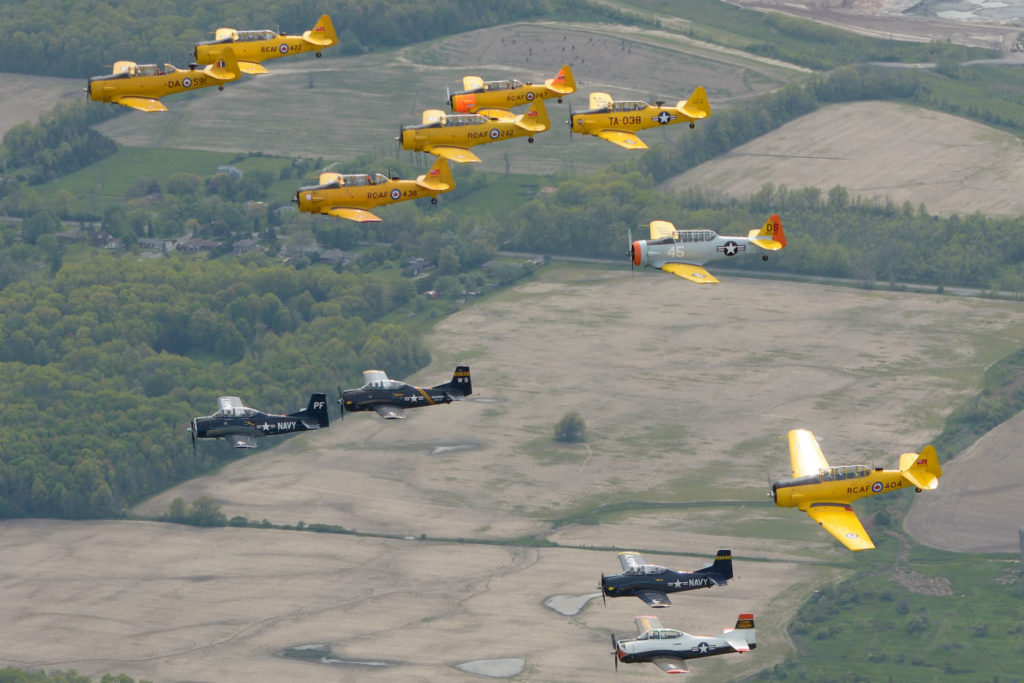Estimated reading time 6 minutes, 50 seconds.
More than a dozen ex-military training aircraft took to the skies over southern Ontario last weekend during a North American Trainer Association (NATA) international formation clinic held at the Canadian Warplane Heritage Museum (CWHM) in Hamilton, Ont.

NATA was founded in 1985 and is dedicated to helping civilians acquire, operate, maintain and safely fly North American Aviation Company aircraft built in the 1940s and 1950s. Aircraft covered by the association include the TF-51, a trainer version of the P-51 Mustang; the TB-25 Mitchell; the T-28 Trojan; and the NA-50/NA-64/T-6/SNJ and Canadian-built Harvard trainers.
One of NATA’s main missions is teaching formation flying for aerial displays. NATA is a signatory of the Formation and Safety Team (FAST), a worldwide organization that teaches formation flying in ex-military and civilian aircraft. At a NATA formation clinic, pilots strive to earn their FAST card, which will give them the skills to fly safely in large formations. Qualifications include wingman, leader, instructor and check pilot.
Canadian and United States regulations differ when it comes to formation flying displays. In the U.S., the Federal Aviation Administration (FAA) requires a FAST card for each pilot, whereas in Canada the performers need to prove they have practiced their display within a certain amount of days before the show. For a formation flight of four aircraft or less, the Canadian requirement is to have practiced within the last 30 days. Formations with more than four aircraft need to have flown a practice within the last 15 days. Most often, practices are held on site the day before the airshow. With that said, Canadian air bosses and organizers often prefer performers with FAST cards.
The NATA formation clinic at the CWHM was held May 18 to 21 and attracted 10 Harvard/T-6s and four T-28 Trojans. While many of the participants came from Ontario, some owners travelled from as far away as Maryland and Indiana. Aircraft began to arrive on May 18 and clear skies allowed each group to fly up to four training flights a day on May 19 and 20. Training flights consisted of two ships for beginners as well as three- and four-ship flights for intermediate pilots. Often, three and four flights would depart at the same time so two sectors (red and green) were assigned, and within each sector a high flight and low flight would operate at different altitudes.
Following NATA FAST procedures, each flight pre-briefed the mission. This included what sector would be used and whether they were the high flight or low flight. Radio frequencies for start-up, ground, tower, en route and practice area were reviewed. Upon takeoff, the flights made a climbing orbit over the field for all aircraft to form up, then they headed to their sector. Once on station, the lead aircraft would lead the formation through a series of manoeuvres. Each student had a certified instructor in the back seat to coach them through the exercise.

Basically, they started off in a delta or diamond formation. Each formation made a left- and right-hand turn; then the lead, with hand signals, would change the formation to echelon left or right, trail or finger four. This was followed by a hard break and tail chase with several hundred feet separating the aircraft. The students then reformed on the leader. The leader held a bank angle allowing the other pilots to get a bearing line and close the distance until they were back in formation. The whole exercise was then repeated with a second join-up. At that time, they proceeded back to Hamilton airport to join the circuit, move to echelon formation and over-fly the runway at circuit altitude, where each pilot would then peel off to provide separation for landing. A debrief followed.
As a first priority, any safety issues were addressed. Starting with the last member of the flight, they replayed the whole flight and discussed any issues or concerns. Instructors then gave valuable information on what was done wrong and how students could have improved the situation. Often, debriefs took up to an hour. A short break was provided before heading out on the next flight. On the average, most flights lasted 45 minutes.
Over the clinic period, more than two dozen missions were flown. The final flight was a massed flight over Niagara Falls for a photo op. Speed differences between the Harvard/T-6s and T-28 Trojans were too great, so the flight was broken into three sections.
The formation was called “Big Bird Flight” and was led by Dr. Dave Martin. It consisted of eight Harvard/T-6s broken into A and B flight and the four T-28s as C flight. The CWHM provided its Beech 18 as a photo ship. Departing Runway 6 at Hamilton, the two flights of Harvards met over Binbrook, then preceded to the lakeshore where the Beech 18, flown by Leon Evans and Bill Craig, moved in for photos on the way to Niagara Falls. The T-28s followed and with their faster speed made several close passes by the Harvards in order for photographs to be taken of the whole flight. Three orbits were made over Niagara Falls and then the formation returned to Hamilton.
More information can be found on the NATA website.








